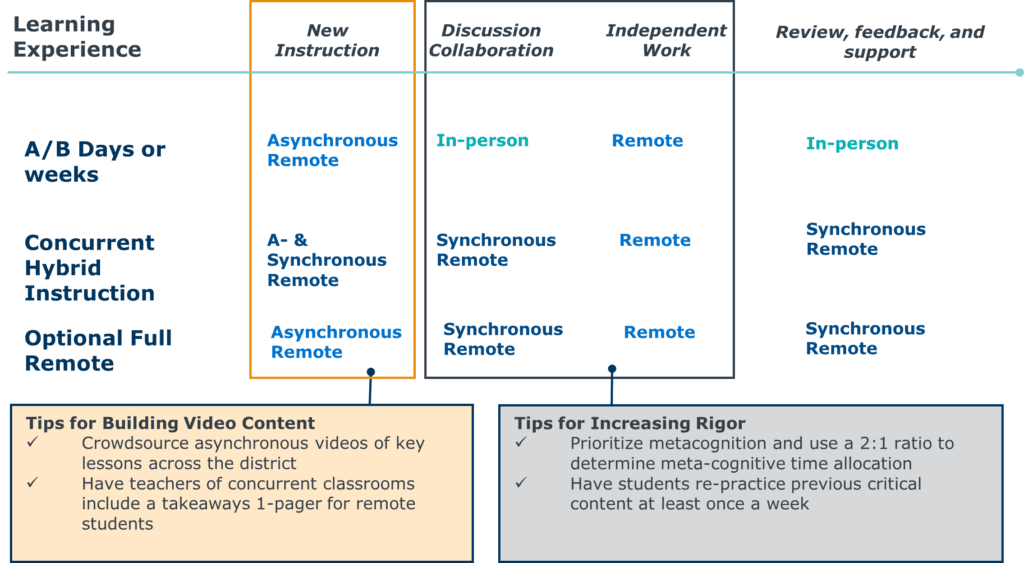Benefits and Drawbacks to Concurrent Instruction in K-12
As school district administrators explore how to best educate their students during the COVID-19 pandemic, some administrators have turned to a concurrent instruction model. Universities have used concurrent instruction (often known as HyFlex in a higher-education context) for years, but school districts rarely implemented the model prior to this year.
District administrators across the nation implemented concurrent instruction this year
Although the precise number of school districts that currently use concurrent instruction remains unclear, EAB interviews find implementation fairly common across the country. For example, the following districts currently use—or plan to implement—concurrent instruction.

- Fairfax County Public Schools (187,797 students): According to this district’s updates, the district has begun to use concurrent instruction for both elementary school and secondary school.
- Stamford Public Schools (15,942 students): This district’s Reopening Plan indicates that administrators split students into two cohorts, each attending in-person school two days per week. Students in the other cohort attend classes via live-streamed instruction.
- Pelham Public Schools (2,896 students): According to this district’s Model Overview, administrators split students into two cohorts, each of which attends school in-person two days per week. While one cohort learns in school, the other cohort attends the same lesson at home.
EAB identified significant drawbacks to concurrent instruction
While peer-reviewed research on the long-term effectiveness of K-12 concurrent instruction has yet to emerge, EAB’s interviews with dozens of district leaders and virtual learning research experts across the country revealed the following advantages and disadvantages to concurrent instruction.
Advantages
- Concurrent instruction prevents the need for additional staff. Under a concurrent instruction model, the same teachers can instruct both virtual and in-person students. EAB interviews indicate that many districts turn to concurrent instruction due to staffing constraints.
- Concurrent instruction permits greater flexibility. Students may attend class either at home or in-person without needing to switch teachers should they need to stay home for several weeks.
Disadvantages
- Virtual students find concurrent instruction disengaging. EAB interviews suggest that students receiving virtual instruction through a concurrent instruction model often feel disengaged. Oftentimes, teachers find it difficult to pay enough attention to both in-person and virtual students to engage both groups during a class.
- Teachers find it difficult to manage students both virtually and in–person simultaneously. EAB interviews suggest that teachers struggle to manage the behavior of both virtual and in-person students at the same time.
- Consistent technological issues disrupt teaching. In Sarasota County School District (FL), teachers at the district note that dealing with constant technology issues (e.g., adjusting the camera, troubleshooting a student’s microphone) consistently disrupt teaching. Further, 77 percent of teachers at the district do not believe that concurrent instruction constitutes an effective instructional model, according to a survey completed by the district. Only six percent of Sarasota teachers believe that concurrent instruction constitutes an effective instructional model.
- Time-consuming logistics cut into planning time.Teachers at Pinellas County Schools(FL) find that administrative tasks required by concurrent instruction, such as responding to emails and technological set-up, prevent teachers from adequately preparing for lessons. Similarly, at Valparaiso Community Schools(IL), teachers emphasize that they do not have time toplan for both students learning in-person and virtually.
As a result, EAB rated the learning efficacy of concurrent instruction a C-. See the below graphic for how EAB rated other instructional models. Note that our ratings of the ‘A/B days’ and ‘A/B weeks’ models do not involve concurrent instruction.
Hybrid instructional model ratings
| Hybrid Model | Safety | Learning Efficacy | Implementation Complexity | Tips and Insights |
| A/B Days | A- | B+ | B | Prioritize in-person instruction to review content, facilitate metacognition and provide targeted support |
| A/B Weeks | A- | C- | B | If possible, move to an A/B day instead. A/B weeks could decrease student engagement and learning |
| Concurrent Hybrid Instruction | B | C- | B+ | Assign someone to monitor the virtual students during class; Ideally, designate teachers to be either in-person or virtual |
| In Person for High Needs or Disengaged Groups | A- | A- | B- | Rotate young students (A/B) in building; Recommend in-person to families of high needs students via email, phone and during parent conferences; emphasize learning impact |
| Optional in-person learning for all | C- | B | B+ | Expect more students than planned; could pose health & safety risks |
Instead of concurrent instruction, assign teachers to instruct either virtually or in-person if feasible
Instead of using concurrent instruction, administrators may consider assigning individual teachers or specific periods for all teachers to dedicate to virtual instruction. Interviews with EAB partners illuminated how several partner districts plan to provide both virtual and in-person instruction for elementary and secondary school students:
Grades K-6
- Administrators dedicate teachers to instruct virtual students. Teachers assigned to virtual instruction do not instruct in-person students.
Grades 7-12
- Administrators can require teachers to teach a mix of in-person classes and virtual classes but not concurrently. Teachers can lead one period of synchronous virtual instruction per day. For example, a math teacher can lead virtual synchronous instruction during third period each day. The teacher would not instruct in-building students during third period.

Shift pedagogy to optimize concurrent instruction
If your district opts to use concurrent instruction, use the following practices gathered through EAB interviews to maximize the model’s effectiveness.
- Assign a student to monitor virtual students and chat feature. Since teachers cannot always pay full attention to both virtual and in-person students, assign a student to manage the videoconferencing platform’s chat feature. These students can raise virtual students’ questions to the teacher.
- Ensure teachers engage virtual student every few minutes. Virtual students often do not receive enough attention during concurrent instruction classes. Teachers should explicitly engage virtual students with a question or request every few minutes.
- Align teaching with student attention span. As a rule of thumb, add two to a student’s age to determine their attention span. For example, the attention span of a fifth grader should be around 12-13 minutes. Ensure lesson plans do not overstretch students’ attention spans—especially for virtual students.
Further, use the following key practices from Cornell University’s Center for Teaching and Learning,the Forbes article Optimizing Concurrent Classrooms,and the Inside Higher ED article 6 Tips for Teaching Online and In-Person Simultaneously to further maximize concurrent instruction’s effectiveness.
- Employ interactive polls (e.g., polls that go beyond a multiple-choice response) so in-person students can interact with virtual student responses and vice versa.
- Divide students into groups often and give groups a specific task. Use Zoom breakout rooms for virtual students to ensure they can communicate clearly with each other. Assigning a specific task that groups must complete will help both in-person and virtual groups remain engaged.
- Encourage teachers to repeat each student question or comment out loud to ensure both virtual and in-person students can hear and understand other students’ questions. Also, students should verbally share comments and well as write them in a virtual chat.
Next, see EAB’s graphic below for how we recommend teachers deliver various learning experiences in different instructional models. For example, if your district plans to implement concurrent instruction, EAB recommends teachers introduce new content during both asynchronous and synchronous remote instructional time.

Lastly, for best practices in virtual instruction, see EAB’s list of resources below.

Virtual Instruction Checklist for K-12 Educators: This checklist offers 20 research-backed techniques to collectively improve learning outcomes in a virtual setting. Educators should use this checklist to audit their approach to virtual instruction, inform lesson planning, and improve practice.

Motivate Disengaged Students in Virtual Instruction: This training video is the first installment in a six-part professional development series aimed at supporting teachers in improving virtual instruction through five easy-to-implement strategies to recapture disengaged students in virtual learning.

Increasing Retention in the Virtual K-12 Classroom: See this video to learn how the brain develops and retrieves long-term memories and the four simple strategies you can use to help students retain information in your virtual classroom.

Curricula Prioritization Tool: Use this tool to identify and prioritize high-value content and skills within your existing curricula to maximize limited instruction time this school year.
Next, check-out our virtual instruction checklist for K-12 educators, which contains over 20 virtual teaching strategies that improve student learning outcomes for.
This resource requires EAB partnership access to view.
Access the research report
Learn how you can get access to this resource as well as hands-on support from our experts through District Leadership Forum.
Learn More